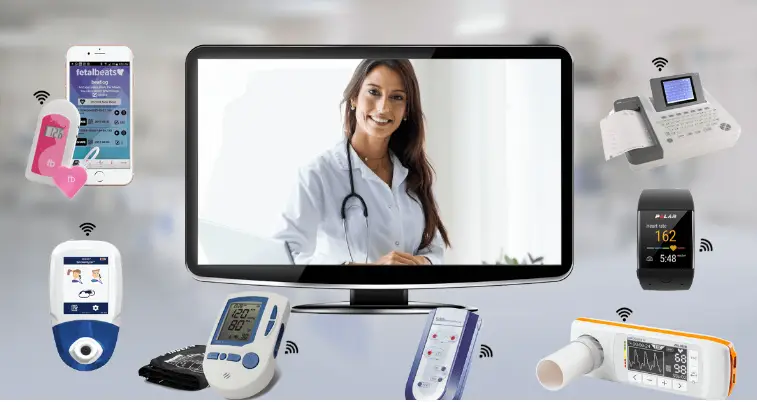How to use remote patient monitoring with telehealth
Remote patient monitoring pairs well with telehealth when patients need to be monitored for certain health conditions. It can also prevent health complications in patients who aren’t able to easily travel.
There are many symptoms and conditions that can be tracked through remote patient monitoring, including:

- High blood pressure
- Diabetes
- Weight loss or gain
- Heart conditions
- Chronic obstructive pulmonary disease
- Sleep apnea
- Asthma
Many of the devices that patients will use may be familiar to them, including:
- Weight scales
- Pulse oximeters
- Blood glucose meters
- Blood pressure monitors
Other conditions require more complicated devices that will require patient training, including:
- Apnea monitors
- Heart monitors
- Specialized monitors for dementia and Parkinson’s disease
- Breathing apparatuses
- Fetal monitors
As the popularity and convenience of telehealth grows, so does remote patient monitoring. More providers are implementing remote patient monitoring for several reasons, including:
- Advanced medical technology
- A growing awareness of telehealth for providers and patients
- More insurance coverage during the COVID-19 public health emergency
- The ability to monitor and prevent serious complications in remote locations
How to help patients use at-home health monitors
Remote monitoring may be new for your patients, and for you also. The best way to help your patients is to be informed about the devices you will be using. This includes how they work and how you will receive the data from the device.
Make sure patient understands why you are prescribing at-home health monitors
There are a number of ways to share information with your patients:
- A telehealth appointment before they begin using the device
- A follow-up telehealth appointment after they’ve been using the device for several days
- An email or downloadable PDF explaining remote patient monitoring for their condition or symptoms
Help your patient understand how to use their device
Some products, such as a weight scale, may not need a lot of explanation. But other devices may be more high tech or confusing for patients. Here’s a few tips:
- Walk your patient through operating the device in a telehealth appointment
- Refer your patient to an at-home medical equipment provider in their area who can set them up with the device and provide support
- Tell your patient what types of readings you will get from their device and how you will receive that information
- Make sure your patient has written instructions they can refer to, including paper copies, email, or downloadable PDF
- Encourage your patient to write down their questions and either call your office, email you the questions through a patient portal, or request a follow-up telehealth appointment
- Have a member of your staff let your patient know when you are receiving their information correctly from the device
Talk to your patients about the benefits of remote patient monitoring
Some patients will need in-person testing, diagnostics, or monitoring. This depends on their condition, Internet capabilities, or personal preferences and abilities. But there are many ways that remote patient monitoring can help with chronic conditions, pregnancy complications, and short-term illness.
These benefits include:
- Reduced hospitalizations
- Shorter hospital stays if the patient can be discharged with a remote monitoring device to use at home
- Fewer visits to the emergency room
- Better health outcomes for patients in rural areas
- Better preventative management for chronic conditions
- Reduced risk of COVID-19 exposure, along with other illnesses, for patients and health care workers

